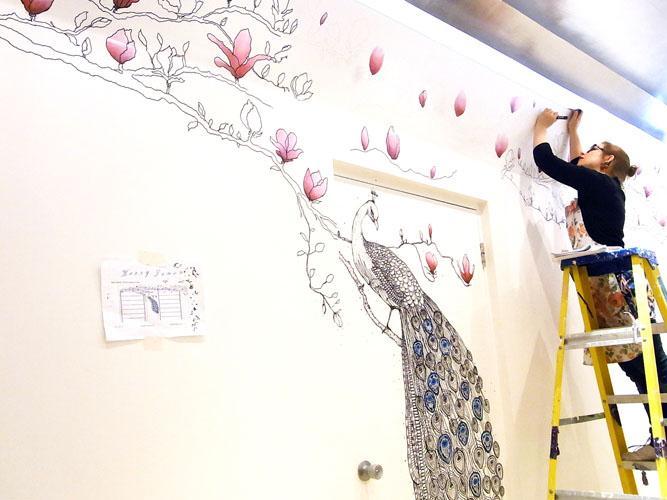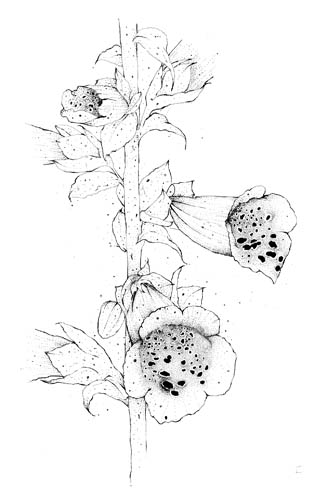Kerry Lemon is an artist creating drawings for architecture, retail, editorial, publishing and advertising clients, including Sony Japan, Virgin Airways and the LA Times. She is a big fan of intricate pen drawing, soft colours, pink wafer biscuits, oceans of tea – and plants.

Kerry Lemon illustrates nature scenes in detailed line drawings with bright splashes of color.
RB: Is it fair to say plants are your favorite subject? I’d love to hear how this fascination started– was there a garden you played in as a child?

Studying the molecular mechanisms of plant development has yielded fruit for Kerry. Cherries, illustrated by Kerry Lemon.
KL: Yes plants are absolutely my favourite subject! I’ve always loved to draw flowers and actually did work experience as a florist when I was at school, (but I soon realised that this career would not be compatible with my hay fever!) My Dad has always bought my mum flowers on special occasions, and I loved the way that they transformed the room with scent, beauty and colour. I think it was these cut flowers more than any garden that inspired me as a child.
RB: You’re currently in a residency at Royal Holloway University, working with scientists to bring the plants you draw to life with modern molecular biology tools. I think this is brilliant (obviously) - our vision is to one day be able to design & grow custom flowers personalized for your loved ones. What designs are you most excited about?
KL: I had this idea about five years ago, the notion that I wanted to find out if I could draw a plant and then make it come to life. I am very lucky to be funded by Ted Baker to complete this residency, and to be working with the wonderful (and ever patient!) Prof Laszlo Bogre and his team at Royal Holloway University. I stopped studying science aged 16, and so I have a HUGE amount of learning to do. This residency is allowing me to attend tutorials, lectures and practicals, conduct experiments, shadow scientists at their work, and really explore what is possible.

The anatomical intricacies of petal, calyx, stem, and leaf are captured in Kerry’s drawings.
At this stage I’m really just learning about the theoretical possibilities, creatingdrawings and then sitting with scientists to understand the science behind the drawings I’m creating. This is THE MOST EXCITING project I have ever worked on, due to time constraints it is unlikely I will be able to physically create any plants, but I will be able to design new plants and to fully understand how they could be made and function in the real world.
RB: Art and science approach questions of reality and truth from very different perspectives. What has most surprised you in your work with the scientists, and how does what you learn in the lab translate back into your artwork?
KL: I have found lots of similarities in approach, passion and exploration with scientists. I guess the main difference is that whilst scientists and artists both pose questions, scientists seek to find answers. In the planning stages of this project the scientists wanted to know what I was going to do and how I was going to do it, as this is how their work is structured. As an artist, you know where you are going to begin, but the creative process is damaged if you have to prescribe the course of direction and outcomes in advance. What I am learning in the lab is not just informing my artwork (although of it is doing that also), it is informing my understanding of the world around me. This is a profound effect of the residency, and one which I didn’t predict.
Thank you for speaking with us Kerry! We hope your cats refrain from taking your art supplies hostage long enough for you to design a flower for us to build. Readers, Kerry is supporting our crowdfunding effort to develop color changing flowers with a beautiful custom flower giclee print. Take a look!
